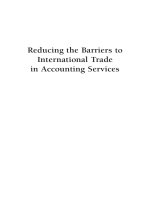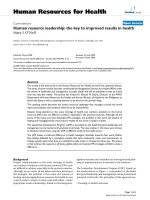The Microguide to Process Modeling in Bpmn 2.0 by MR Tom Debevoise and Rick Geneva_9 potx
Bạn đang xem bản rút gọn của tài liệu. Xem và tải ngay bản đầy đủ của tài liệu tại đây (1.97 MB, 27 trang )
4. Process Modeling
4.6. Case Studies in Process Modeling
4.6.1. Load Cell Calibration
4.6.1.9.Interpretation of Numerical Output -
Model #2
Quadratic
Confirmed
The numerical results from the fit are shown below. For the quadratic model, the
lack-of-fit test statistic is 0.8107. The fact that the test statistic is approximately one
indicates there is no evidence to support a claim that the functional part of the model
does not fit the data. The test statistic would have had to have been greater than 2.17
to reject the hypothesis that the quadratic model is correct.
Dataplot
Output
LEAST SQUARES POLYNOMIAL FIT
SAMPLE SIZE N = 40
DEGREE = 2
REPLICATION CASE
REPLICATION STANDARD DEVIATION = 0.2147264895D-03
REPLICATION DEGREES OF FREEDOM = 20
NUMBER OF DISTINCT SUBSETS = 20
PARAMETER ESTIMATES (APPROX. ST. DEV.) T VALUE
1 A0 0.673618E-03 (0.1079E-03) 6.2
2 A1 0.732059E-06 (0.1578E-09) 0.46E+04
3 A2 -0.316081E-14 (0.4867E-16) -65.
RESIDUAL STANDARD DEVIATION = 0.0002051768
RESIDUAL DEGREES OF FREEDOM = 37
REPLICATION STANDARD DEVIATION = 0.0002147265
REPLICATION DEGREES OF FREEDOM = 20
LACK OF FIT F RATIO = 0.8107 = THE 33.3818% POINT OF
THE F DISTRIBUTION WITH 17 AND 20 DEGREES OF FREEDOM
Regression
Function
From the numerical output, we can also find the regression function that will be used
for the calibration. The function, with its estimated parameters, is
4.6.1.9. Interpretation of Numerical Output - Model #2
(1 of 2) [5/1/2006 10:22:36 AM]
All of the parameters are significantly different from zero, as indicated by the
associated t statistics. The 97.5% cut-off for the t distribution with 37 degrees of
freedom is 2.026. Since all of the t values are well above this cut-off, we can safely
conclude that none of the estimated parameters is equal to zero.
4.6.1.9. Interpretation of Numerical Output - Model #2
(2 of 2) [5/1/2006 10:22:36 AM]
4. Process Modeling
4.6. Case Studies in Process Modeling
4.6.1. Load Cell Calibration
4.6.1.10.Use of the Model for Calibration
Using the
Model
Now that a good model has been found for these data, it can be used to estimate load values for
new measurements of deflection. For example, suppose a new deflection value of 1.239722 is
observed. The regression function can be solved for load to determine an estimated load value
without having to observe it directly. The plot below illustrates the calibration process
graphically.
Calibration
Finding
Bounds on
the Load
From the plot, it is clear that the load that produced the deflection of 1.239722 should be about
1,750,000, and would certainly lie between 1,500,000 and 2,000,000. This rough estimate of the
possible load range will be used to compute the load estimate numerically.
4.6.1.10. Use of the Model for Calibration
(1 of 3) [5/1/2006 10:22:37 AM]
Obtaining
a
Numerical
Calibration
Value
To solve for the numerical estimate of the load associated with the observed deflection, the
observed value substituting in the regression function and the equation is solved for load.
Typically this will be done using a root finding procedure in a statistical or mathematical
package. That is one reason why rough bounds on the value of the load to be estimated are
needed.
Solving the
Regression
Equation
Which
Solution?
Even though the rough estimate of the load associated with an observed deflection is not
necessary to solve the equation, the other reason is to determine which solution to the equation is
correct, if there are multiple solutions. The quadratic calibration equation, in fact, has two
solutions. As we saw from the plot on the previous page, however, there is really no confusion
over which root of the quadratic function is the correct load. Essentially, the load value must be
between 150,000 and 3,000,000 for this problem. The other root of the regression equation and
the new deflection value correspond to a load of over 229,899,600. Looking at the data at hand, it
is safe to assume that a load of 229,899,600 would yield a deflection much greater than 1.24.
+/- What? The final step in the calibration process, after determining the estimated load associated with the
observed deflection, is to compute an uncertainty or confidence interval for the load. A single-use
95% confidence interval for the load, is obtained by inverting the formulas for the upper and
lower bounds of a 95% prediction interval for a new deflection value. These inequalities, shown
below, are usually solved numerically, just as the calibration equation was, to find the end points
of the confidence interval. For some models, including this one, the solution could actually be
obtained algebraically, but it is easier to let the computer do the work using a generic algorithm.
The three terms on the right-hand side of each inequality are the regression function ( ), a
t-distribution multiplier, and the standard deviation of a new measurement from the process (
).
Regression software often provides convenient methods for computing these quantities for
arbitrary values of the predictor variables, which can make computation of the confidence interval
end points easier. Although this interval is not symmetric mathematically, the asymmetry is very
small, so for all practical purposes, the interval can be written as
4.6.1.10. Use of the Model for Calibration
(2 of 3) [5/1/2006 10:22:37 AM]
if desired.
4.6.1.10. Use of the Model for Calibration
(3 of 3) [5/1/2006 10:22:37 AM]
4. Process Modeling
4.6. Case Studies in Process Modeling
4.6.1. Load Cell Calibration
4.6.1.11.Work This Example Yourself
View
Dataplot
Macro for
this Case
Study
This page allows you to repeat the analysis outlined in the case study
description on the previous page using Dataplot, if you have
downloaded and installed it. Output from each analysis step below will
be displayed in one or more of the Dataplot windows. The four main
windows are the Output window, the Graphics window, the Command
History window and the Data Sheet window. Across the top of the main
windows there are menus for executing Dataplot commands. Across the
bottom is a command entry window where commands can be typed in.
Data Analysis Steps Results and Conclusions
Click on the links below to start Dataplot and run this
case study yourself. Each step may use results from
previous steps, so please be patient. Wait until the
software verifies that the current step is complete
before clicking on the next step.
The links in this column will connect you with more detailed
information about each analysis step from the case study
description.
1. Get set up and started.
1. Read in the data.
1. You have read 2 columns of numbers
into Dataplot, variables Deflection
and Load.
2. Fit and validate initial model.
1. Plot deflection vs. load.
2. Fit a straight-line model
to the data.
3. Plot the predicted values
1. Based on the plot, a straight-line
model should describe the data well.
2. The straight-line fit was carried
out. Before trying to interpret the
numerical output, do a graphical
residual analysis.
3. The superposition of the predicted
4.6.1.11. Work This Example Yourself
(1 of 3) [5/1/2006 10:22:37 AM]
from the model and the
data on the same plot.
4. Plot the residuals vs.
load.
5. Plot the residuals vs. the
predicted values.
6. Make a 4-plot of the
residuals.
7. Refer to the numerical output
from the fit.
and observed values suggests the
model is ok.
4. The residuals are not random,
indicating that a straight line
is not adequate.
5. This plot echos the information in
the previous plot.
6. All four plots indicate problems
with the model.
7. The large lack-of-fit F statistic
(>214) confirms that the straight-
line model is inadequate.
3. Fit and validate refined model.
1. Refer to the plot of the
residuals vs. load.
2. Fit a quadratic model to
the data.
3. Plot the predicted values
from the model and the
data on the same plot.
4. Plot the residuals vs. load.
5. Plot the residuals vs. the
predicted values.
6. Do a 4-plot of the
residuals.
7. Refer to the numerical
output from the fit.
1. The structure in the plot indicates
a quadratic model would better
describe the data.
2. The quadratic fit was carried out.
Remember to do the graphical
residual analysis before trying to
interpret the numerical output.
3. The superposition of the predicted
and observed values again suggests
the model is ok.
4. The residuals appear random,
suggesting the quadratic model is ok.
5. The plot of the residuals vs. the
predicted values also suggests the
quadratic model is ok.
6. None of these plots indicates a
problem with the model.
7. The small lack-of-fit F statistic
(<1) confirms that the quadratic
model fits the data.
4.6.1.11. Work This Example Yourself
(2 of 3) [5/1/2006 10:22:37 AM]
4. Use the model to make a calibrated
measurement.
1. Observe a new deflection
value.
2. Determine the associated
load.
3. Compute the uncertainty of
the load estimate.
1. The new deflection is associated with
an unobserved and unknown load.
2. Solving the calibration equation
yields the load value without having
to observe it.
3. Computing a confidence interval for
the load value lets us judge the
range of plausible load values,
since we know measurement noise
affects the process.
4.6.1.11. Work This Example Yourself
(3 of 3) [5/1/2006 10:22:37 AM]
4. Process Modeling
4.6. Case Studies in Process Modeling
4.6.2.Alaska Pipeline
Non-Homogeneous
Variances
This example illustrates the construction of a linear regression
model for Alaska pipeline ultrasonic calibration data. This case
study demonstrates the use of transformations and weighted fits to
deal with the violation of the assumption of constant standard
deviations for the random errors. This assumption is also called
homogeneous variances for the errors.
Background and Data1.
Check for a Batch Effect2.
Fit Initial Model3.
Transformations to Improve Fit and Equalize Variances4.
Weighting to Improve Fit5.
Compare the Fits6.
Work This Example Yourself7.
4.6.2. Alaska Pipeline
[5/1/2006 10:22:37 AM]
4. Process Modeling
4.6. Case Studies in Process Modeling
4.6.2. Alaska Pipeline
4.6.2.1.Background and Data
Description
of Data
Collection
The Alaska pipeline data consists of in-field ultrasonic measurements of
the depths of defects in the Alaska pipeline. The depth of the defects
were then re-measured in the laboratory. These measurements were
performed in six different batches.
The data were analyzed to calibrate the bias of the field measurements
relative to the laboratory measurements. In this analysis, the field
measurement is the response variable and the laboratory measurement is
the predictor variable.
These data were provided by Harry Berger, who was at the time a
scientist for the Office of the Director of the Institute of Materials
Research (now the Materials Science and Engineering Laboratory) of
NIST. These data were used for a study conducted for the Materials
Transportation Bureau of the U.S. Department of Transportation.
Resulting
Data
Field Lab
Defect Defect
Size Size Batch
18 20.2 1
38 56.0 1
15 12.5 1
20 21.2 1
18 15.5 1
36 39.0 1
20 21.0 1
43 38.2 1
45 55.6 1
65 81.9 1
43 39.5 1
38 56.4 1
33 40.5 1
4.6.2.1. Background and Data
(1 of 4) [5/1/2006 10:22:37 AM]
10 14.3 1
50 81.5 1
10 13.7 1
50 81.5 1
15 20.5 1
53 56.0 1
60 80.7 2
18 20.0 2
38 56.5 2
15 12.1 2
20 19.6 2
18 15.5 2
36 38.8 2
20 19.5 2
43 38.0 2
45 55.0 2
65 80.0 2
43 38.5 2
38 55.8 2
33 38.8 2
10 12.5 2
50 80.4 2
10 12.7 2
50 80.9 2
15 20.5 2
53 55.0 2
15 19.0 3
37 55.5 3
15 12.3 3
18 18.4 3
11 11.5 3
35 38.0 3
20 18.5 3
40 38.0 3
50 55.3 3
36 38.7 3
50 54.5 3
38 38.0 3
10 12.0 3
75 81.7 3
10 11.5 3
85 80.0 3
13 18.3 3
50 55.3 3
58 80.2 3
58 80.7 3
4.6.2.1. Background and Data
(2 of 4) [5/1/2006 10:22:37 AM]
48 55.8 4
12 15.0 4
63 81.0 4
10 12.0 4
63 81.4 4
13 12.5 4
28 38.2 4
35 54.2 4
63 79.3 4
13 18.2 4
45 55.5 4
9 11.4 4
20 19.5 4
18 15.5 4
35 37.5 4
20 19.5 4
38 37.5 4
50 55.5 4
70 80.0 4
40 37.5 4
21 15.5 5
19 23.7 5
10 9.8 5
33 40.8 5
16 17.5 5
5 4.3 5
32 36.5 5
23 26.3 5
30 30.4 5
45 50.2 5
33 30.1 5
25 25.5 5
12 13.8 5
53 58.9 5
36 40.0 5
5 6.0 5
63 72.5 5
43 38.8 5
25 19.4 5
73 81.5 5
45 77.4 5
52 54.6 6
9 6.8 6
30 32.6 6
22 19.8 6
56 58.8 6
4.6.2.1. Background and Data
(3 of 4) [5/1/2006 10:22:37 AM]
15 12.9 6
45 49.0 6
4.6.2.1. Background and Data
(4 of 4) [5/1/2006 10:22:37 AM]
4. Process Modeling
4.6. Case Studies in Process Modeling
4.6.2. Alaska Pipeline
4.6.2.2.Check for Batch Effect
Plot of Raw
Data
As with any regression problem, it is always a good idea to plot the raw data first. The following
is a scatter plot of the raw data.
This scatter plot shows that a straight line fit is a good initial candidate model for these data.
Plot by Batch These data were collected in six distinct batches. The first step in the analysis is to determine if
there is a batch effect.
In this case, the scientist was not inherently interested in the batch. That is, batch is a nuisance
factor and, if reasonable, we would like to analyze the data as if it came from a single batch.
However, we need to know that this is, in fact, a reasonable assumption to make.
4.6.2.2. Check for Batch Effect
(1 of 3) [5/1/2006 10:22:38 AM]
Conditional
Plot
We first generate a conditional plot where we condition on the batch.
This conditional plot shows a scatter plot for each of the six batches on a single page. Each of
these plots shows a similar pattern.
Linear
Correlation
and Related
Plots
We can follow up the conditional plot with a linear correlation plot, a linear intercept plot, a
linear slope plot, and a linear residual standard deviation plot. These four plots show the
correlation, the intercept and slope from a linear fit, and the residual standard deviation for linear
fits applied to each batch. These plots show how a linear fit performs across the six batches.
4.6.2.2. Check for Batch Effect
(2 of 3) [5/1/2006 10:22:38 AM]
The linear correlation plot (upper left), which shows the correlation between field and lab defect
sizes versus the batch, indicates that batch six has a somewhat stronger linear relationship
between the measurements than the other batches do. This is also reflected in the significantly
lower residual standard deviation for batch six shown in the residual standard deviation plot
(lower right), which shows the residual standard deviation versus batch. The slopes all lie within
a range of 0.6 to 0.9 in the linear slope plot (lower left) and the intercepts all lie between 2 and 8
in the linear intercept plot (upper right).
Treat BATCH
as
Homogeneous
These summary plots, in conjunction with the conditional plot above, show that treating the data
as a single batch is a reasonable assumption to make. None of the batches behaves badly
compared to the others and none of the batches requires a significantly different fit from the
others.
These two plots provide a good pair. The plot of the fit statistics allows quick and convenient
comparisons of the overall fits. However, the conditional plot can reveal details that may be
hidden in the summary plots. For example, we can more readily determine the existence of
clusters of points and outliers, curvature in the data, and other similar features.
Based on these plots we will ignore the BATCH variable for the remaining analysis.
4.6.2.2. Check for Batch Effect
(3 of 3) [5/1/2006 10:22:38 AM]
4. Process Modeling
4.6. Case Studies in Process Modeling
4.6.2. Alaska Pipeline
4.6.2.3.Initial Linear Fit
Linear Fit Output Based on the initial plot of the data, we first fit a straight-line model to the data.
The following fit output was generated by Dataplot (it has been edited slightly for display).
LEAST SQUARES MULTILINEAR FIT
SAMPLE SIZE N = 107
NUMBER OF VARIABLES = 1
REPLICATION CASE
REPLICATION STANDARD DEVIATION = 0.6112687111D+01
REPLICATION DEGREES OF FREEDOM = 29
NUMBER OF DISTINCT SUBSETS = 78
PARAMETER ESTIMATES (APPROX. ST. DEV.) T
VALUE
1 A0 4.99368 ( 1.126 )
4.4
2 A1 LAB 0.731111 (0.2455E-01)
30.
RESIDUAL STANDARD DEVIATION = 6.0809240341
RESIDUAL DEGREES OF FREEDOM = 105
REPLICATION STANDARD DEVIATION = 6.1126871109
REPLICATION DEGREES OF FREEDOM = 29
LACK OF FIT F RATIO = 0.9857
= THE 46.3056% POINT OF THE
F DISTRIBUTION WITH 76 AND 29 DEGREES OF FREEDOM
The intercept parameter is estimated to be 4.99 and the slope parameter is estimated to be 0.73.
Both parameters are statistically significant.
4.6.2.3. Initial Linear Fit
(1 of 4) [5/1/2006 10:22:39 AM]
6-Plot for Model
Validation
When there is a single independent variable, the 6-plot provides a convenient method for initial
model validation.
The basic assumptions for regression models are that the errors are random observations from a
normal distribution with mean of zero and constant standard deviation (or variance).
The plots on the first row show that the residuals have increasing variance as the value of the
independent variable (lab) increases in value. This indicates that the assumption of constant
standard deviation, or homogeneity of variances, is violated.
In order to see this more clearly, we will generate full- size plots of the predicted values with the
data and the residuals against the independent variable.
Plot of Predicted
Values with
Original Data
4.6.2.3. Initial Linear Fit
(2 of 4) [5/1/2006 10:22:39 AM]
This plot shows more clearly that the assumption of homogeneous variances for the errors may be
violated.
Plot of Residual
Values Against
Independent
Variable
4.6.2.3. Initial Linear Fit
(3 of 4) [5/1/2006 10:22:39 AM]
This plot also shows more clearly that the assumption of homogeneous variances is violated. This
assumption, along with the assumption of constant location, are typically easiest to see on this
plot.
Non-Homogeneous
Variances
Because the last plot shows that the variances may differ more that slightly, we will address this
issue by transforming the data or using weighted least squares.
4.6.2.3. Initial Linear Fit
(4 of 4) [5/1/2006 10:22:39 AM]
4. Process Modeling
4.6. Case Studies in Process Modeling
4.6.2. Alaska Pipeline
4.6.2.4.Transformations to Improve Fit and Equalize
Variances
Transformations In regression modeling, we often apply transformations to achieve the following two goals:
to satisfy the homogeneity of variances assumption for the errors.1.
to linearize the fit as much as possible.2.
Some care and judgment is required in that these two goals can conflict. We generally try to
achieve homogeneous variances first and then address the issue of trying to linearize the fit.
Plot of Common
Transformations
to Obtain
Homogeneous
Variances
The first step is to try transforming the response variable to find a tranformation that will equalize
the variances. In practice, the square root, ln, and reciprocal transformations often work well for
this purpose. We will try these first.
In examining these plots, we are looking for the plot that shows the most constant variability
across the horizontal range of the plot.
4.6.2.4. Transformations to Improve Fit and Equalize Variances
(1 of 6) [5/1/2006 10:22:40 AM]
This plot indicates that the ln transformation is a good candidate model for achieving the most
homogeneous variances.
Plot of Common
Transformations
to Linearize the
Fit
One problem with applying the above transformation is that the plot indicates that a straight-line
fit will no longer be an adequate model for the data. We address this problem by attempting to
find a transformation of the predictor variable that will result in the most linear fit. In practice, the
square root, ln, and reciprocal transformations often work well for this purpose. We will try these
first.
This plot shows that the ln transformation of the predictor variable is a good candidate model.
Box-Cox
Linearity Plot
The previous step can be approached more formally by the use of the Box-Cox linearity plot. The
value on the x axis corresponding to the maximum correlation value on the y axis indicates the
power transformation that yields the most linear fit.
4.6.2.4. Transformations to Improve Fit and Equalize Variances
(2 of 6) [5/1/2006 10:22:40 AM]
This plot indicates that a value of -0.1 achieves the most linear fit.
In practice, for ease of interpretation, we often prefer to use a common transformation, such as
the ln or square root, rather than the value that yields the mathematical maximum. However, the
Box-Cox linearity plot still indicates whether our choice is a reasonable one. That is, we might
sacrifice a small amount of linearity in the fit to have a simpler model.
In this case, a value of 0.0 would indicate a ln transformation. Although the optimal value from
the plot is -0.1, the plot indicates that any value between -0.2 and 0.2 will yield fairly similar
results. For that reason, we choose to stick with the common ln transformation.
ln-ln Fit
Based on the above plots, we choose to fit a ln-ln model. Dataplot generated the following output
for this model (it is edited slightly for display).
LEAST SQUARES MULTILINEAR FIT
SAMPLE SIZE N = 107
NUMBER OF VARIABLES = 1
REPLICATION CASE
REPLICATION STANDARD DEVIATION = 0.1369758099D+00
REPLICATION DEGREES OF FREEDOM = 29
NUMBER OF DISTINCT SUBSETS = 78
PARAMETER ESTIMATES (APPROX. ST. DEV.) T
VALUE
1 A0 0.281384 (0.8093E-01)
4.6.2.4. Transformations to Improve Fit and Equalize Variances
(3 of 6) [5/1/2006 10:22:40 AM]
3.5
2 A1 XTEMP 0.885175 (0.2302E-01)
38.
RESIDUAL STANDARD DEVIATION = 0.1682604253
RESIDUAL DEGREES OF FREEDOM = 105
REPLICATION STANDARD DEVIATION = 0.1369758099
REPLICATION DEGREES OF FREEDOM = 29
LACK OF FIT F RATIO = 1.7032 = THE 94.4923% POINT OF
THE
F DISTRIBUTION WITH 76 AND 29 DEGREES OF FREEDOM
Note that although the residual standard deviation is significantly lower than it was for the
original fit, we cannot compare them directly since the fits were performed on different scales.
Plot of
Predicted
Values
The plot of the predicted values with the transformed data indicates a good fit. In addition, the
variability of the data across the horizontal range of the plot seems relatively constant.
4.6.2.4. Transformations to Improve Fit and Equalize Variances
(4 of 6) [5/1/2006 10:22:40 AM]
6-Plot of Fit
Since we transformed the data, we need to check that all of the regression assumptions are now
valid.
The 6-plot of the residuals indicates that all of the regression assumptions are now satisfied.
Plot of
Residuals
4.6.2.4. Transformations to Improve Fit and Equalize Variances
(5 of 6) [5/1/2006 10:22:40 AM]









